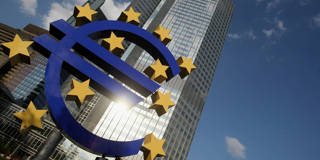Now that the European Central Bank has stoked expectations of additional monetary stimulus, there is a risk that interest rates will snap back upward if it doesn’t deliver at its meeting on September 12. But the ECB would be better advised to postpone any significant further policy loosening.
ZURICH – With economic sentiment in the eurozone worsening rapidly, the European Central Bank is widely expected to announce a robust package of additional stimulus measures at its next meeting on September 12. But although the ECB’s monetary policy has in general been insufficiently expansionary (reflected by persistently below-target eurozone inflation), now is not the right time for fully-fledged monetary-policy easing, including a return to quantitative easing (QE).
For starters, the eurozone economy is in much better shape than it was in March 2015, when the ECB introduced QE. Compared to then, the eurozone composite purchasing managers’ index, a key indicator of business activity, is a little higher. Headline and core inflation are also higher, as are households’ inflation expectations and the European Commission’s economic sentiment indicator. Furthermore, short- and long-term interest rates, and banks’ lending rates, are much lower, and credit growth is stronger. Given such data, it is difficult to make a persuasive case for QE.
True, market-based measures of inflation expectations have collapsed. But that is part of a global phenomenon, and arguably says little about conditions in the eurozone. Moreover, a host of problems related to risk premiums make such indicators hard to interpret. Unsurprisingly, therefore, surveys of households’ and firms’ inflation expectations forecast actual inflation more accurately. Given that the market-based measures currently conflict with most other key economic data as well, little weight should be attached to them.

ZURICH – With economic sentiment in the eurozone worsening rapidly, the European Central Bank is widely expected to announce a robust package of additional stimulus measures at its next meeting on September 12. But although the ECB’s monetary policy has in general been insufficiently expansionary (reflected by persistently below-target eurozone inflation), now is not the right time for fully-fledged monetary-policy easing, including a return to quantitative easing (QE).
For starters, the eurozone economy is in much better shape than it was in March 2015, when the ECB introduced QE. Compared to then, the eurozone composite purchasing managers’ index, a key indicator of business activity, is a little higher. Headline and core inflation are also higher, as are households’ inflation expectations and the European Commission’s economic sentiment indicator. Furthermore, short- and long-term interest rates, and banks’ lending rates, are much lower, and credit growth is stronger. Given such data, it is difficult to make a persuasive case for QE.
True, market-based measures of inflation expectations have collapsed. But that is part of a global phenomenon, and arguably says little about conditions in the eurozone. Moreover, a host of problems related to risk premiums make such indicators hard to interpret. Unsurprisingly, therefore, surveys of households’ and firms’ inflation expectations forecast actual inflation more accurately. Given that the market-based measures currently conflict with most other key economic data as well, little weight should be attached to them.